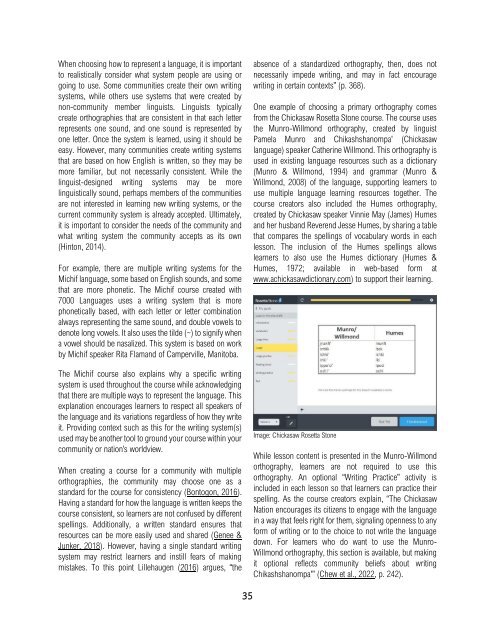Learning in Relation: A Guide to Creating Online Indigenous Language Courses that Center Indigenous Ways of Knowing and Being
by Kari A. B. Chew, Ph.D. (Editor & Author), Melvin Calls Him Jr. (Author), Jackie Dormer (Author), and Courtney Tennell (Author) The purpose of this guide is to share knowledge with Indigenous Nations and organizations, technology developers, and scholars who are working to center and respect Indigenous ways of knowing and being in online Indigenous language revitalization spaces, including Indigenous language courses. Citation Chew, K. A. B. (Ed.). (2022). Learning in relation: A guide to creating online Indigenous language courses that center Indigenous ways of knowing and being. http://hdl.handle.net/1828/14403
by Kari A. B. Chew, Ph.D. (Editor & Author), Melvin Calls Him Jr. (Author), Jackie Dormer (Author), and Courtney Tennell (Author)
The purpose of this guide is to share knowledge with Indigenous Nations and organizations, technology developers, and scholars who are working to center and respect Indigenous ways of knowing and being in online Indigenous language revitalization spaces, including Indigenous language courses.
Citation
Chew, K. A. B. (Ed.). (2022). Learning in relation: A guide to creating online Indigenous language courses that center Indigenous ways of knowing and being. http://hdl.handle.net/1828/14403
You also want an ePaper? Increase the reach of your titles
YUMPU automatically turns print PDFs into web optimized ePapers that Google loves.
When choos<strong>in</strong>g how <strong>to</strong> represent a language, it is important<br />
<strong>to</strong> realistically consider what system people are us<strong>in</strong>g or<br />
go<strong>in</strong>g <strong>to</strong> use. Some communities create their own writ<strong>in</strong>g<br />
systems, while others use systems <strong>that</strong> were created by<br />
non-community member l<strong>in</strong>guists. L<strong>in</strong>guists typically<br />
create orthographies <strong>that</strong> are consistent <strong>in</strong> <strong>that</strong> each letter<br />
represents one sound, <strong>and</strong> one sound is represented by<br />
one letter. Once the system is learned, us<strong>in</strong>g it should be<br />
easy. However, many communities create writ<strong>in</strong>g systems<br />
<strong>that</strong> are based on how English is written, so they may be<br />
more familiar, but not necessarily consistent. While the<br />
l<strong>in</strong>guist-designed writ<strong>in</strong>g systems may be more<br />
l<strong>in</strong>guistically sound, perhaps members <strong>of</strong> the communities<br />
are not <strong>in</strong>terested <strong>in</strong> learn<strong>in</strong>g new writ<strong>in</strong>g systems, or the<br />
current community system is already accepted. Ultimately,<br />
it is important <strong>to</strong> consider the needs <strong>of</strong> the community <strong>and</strong><br />
what writ<strong>in</strong>g system the community accepts as its own<br />
(H<strong>in</strong><strong>to</strong>n, 2014).<br />
For example, there are multiple writ<strong>in</strong>g systems for the<br />
Michif language, some based on English sounds, <strong>and</strong> some<br />
<strong>that</strong> are more phonetic. The Michif course created with<br />
7000 <strong>Language</strong>s uses a writ<strong>in</strong>g system <strong>that</strong> is more<br />
phonetically based, with each letter or letter comb<strong>in</strong>ation<br />
always represent<strong>in</strong>g the same sound, <strong>and</strong> double vowels <strong>to</strong><br />
denote long vowels. It also uses the tilde (~) <strong>to</strong> signify when<br />
a vowel should be nasalized. This system is based on work<br />
by Michif speaker Rita Flam<strong>and</strong> <strong>of</strong> Camperville, Mani<strong>to</strong>ba.<br />
The Michif course also expla<strong>in</strong>s why a specific writ<strong>in</strong>g<br />
system is used throughout the course while acknowledg<strong>in</strong>g<br />
<strong>that</strong> there are multiple ways <strong>to</strong> represent the language. This<br />
explanation encourages learners <strong>to</strong> respect all speakers <strong>of</strong><br />
the language <strong>and</strong> its variations regardless <strong>of</strong> how they write<br />
it. Provid<strong>in</strong>g context such as this for the writ<strong>in</strong>g system(s)<br />
used may be another <strong>to</strong>ol <strong>to</strong> ground your course with<strong>in</strong> your<br />
community or nation’s worldview.<br />
When creat<strong>in</strong>g a course for a community with multiple<br />
orthographies, the community may choose one as a<br />
st<strong>and</strong>ard for the course for consistency (Bon<strong>to</strong>gon, 2016).<br />
Hav<strong>in</strong>g a st<strong>and</strong>ard for how the language is written keeps the<br />
course consistent, so learners are not confused by different<br />
spell<strong>in</strong>gs. Additionally, a written st<strong>and</strong>ard ensures <strong>that</strong><br />
resources can be more easily used <strong>and</strong> shared (Genee &<br />
Junker, 2018). However, hav<strong>in</strong>g a s<strong>in</strong>gle st<strong>and</strong>ard writ<strong>in</strong>g<br />
system may restrict learners <strong>and</strong> <strong>in</strong>still fears <strong>of</strong> mak<strong>in</strong>g<br />
mistakes. To this po<strong>in</strong>t Lillehaugen (2016) argues, “the<br />
absence <strong>of</strong> a st<strong>and</strong>ardized orthography, then, does not<br />
necessarily impede writ<strong>in</strong>g, <strong>and</strong> may <strong>in</strong> fact encourage<br />
writ<strong>in</strong>g <strong>in</strong> certa<strong>in</strong> contexts” (p. 368).<br />
One example <strong>of</strong> choos<strong>in</strong>g a primary orthography comes<br />
from the Chickasaw Rosetta S<strong>to</strong>ne course. The course uses<br />
the Munro-Willmond orthography, created by l<strong>in</strong>guist<br />
Pamela Munro <strong>and</strong> Chikashshanompa' (Chickasaw<br />
language) speaker Cather<strong>in</strong>e Willmond. This orthography is<br />
used <strong>in</strong> exist<strong>in</strong>g language resources such as a dictionary<br />
(Munro & Willmond, 1994) <strong>and</strong> grammar (Munro &<br />
Willmond, 2008) <strong>of</strong> the language, support<strong>in</strong>g learners <strong>to</strong><br />
use multiple language learn<strong>in</strong>g resources <strong>to</strong>gether. The<br />
course crea<strong>to</strong>rs also <strong>in</strong>cluded the Humes orthography,<br />
created by Chickasaw speaker V<strong>in</strong>nie May (James) Humes<br />
<strong>and</strong> her husb<strong>and</strong> Reverend Jesse Humes, by shar<strong>in</strong>g a table<br />
<strong>that</strong> compares the spell<strong>in</strong>gs <strong>of</strong> vocabulary words <strong>in</strong> each<br />
lesson. The <strong>in</strong>clusion <strong>of</strong> the Humes spell<strong>in</strong>gs allows<br />
learners <strong>to</strong> also use the Humes dictionary (Humes &<br />
Humes, 1972; available <strong>in</strong> web-based form at<br />
www.achickasawdictionary.com) <strong>to</strong> support their learn<strong>in</strong>g.<br />
Image: Chickasaw Rosetta S<strong>to</strong>ne<br />
While lesson content is presented <strong>in</strong> the Munro-Willmond<br />
orthography, learners are not required <strong>to</strong> use this<br />
orthography. An optional “Writ<strong>in</strong>g Practice” activity is<br />
<strong>in</strong>cluded <strong>in</strong> each lesson so <strong>that</strong> learners can practice their<br />
spell<strong>in</strong>g. As the course crea<strong>to</strong>rs expla<strong>in</strong>, “The Chickasaw<br />
Nation encourages its citizens <strong>to</strong> engage with the language<br />
<strong>in</strong> a way <strong>that</strong> feels right for them, signal<strong>in</strong>g openness <strong>to</strong> any<br />
form <strong>of</strong> writ<strong>in</strong>g or <strong>to</strong> the choice <strong>to</strong> not write the language<br />
down. For learners who do want <strong>to</strong> use the Munro-<br />
Willmond orthography, this section is available, but mak<strong>in</strong>g<br />
it optional reflects community beliefs about writ<strong>in</strong>g<br />
Chikashshanompa'” (Chew et al., 2022, p. 242).<br />
35




